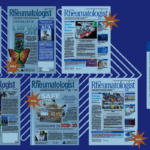 One of the great joys of rheumatology is that it prioritizes systems-based thinking. Whether integrating data from radiographic imaging or piecing together a puzzling case of autoimmunity, rheumatologists are tasked with understanding how systems fundamentally work. In fact, this emphasis on systems-based thinking is often what draws and keeps the best and smartest physicians within our field. Our reluctance to own an organ has led us to gain a wide-ranging perspective on disease, illness and health.
One of the great joys of rheumatology is that it prioritizes systems-based thinking. Whether integrating data from radiographic imaging or piecing together a puzzling case of autoimmunity, rheumatologists are tasked with understanding how systems fundamentally work. In fact, this emphasis on systems-based thinking is often what draws and keeps the best and smartest physicians within our field. Our reluctance to own an organ has led us to gain a wide-ranging perspective on disease, illness and health.
This is even more true today than in the time of our rheumatologic predecessors. Advances in all sorts of diagnostic and treatment modalities have honed our systems-based thinking and have allowed us to improve the lives of many battling autoimmune and musculoskeletal diseases. Our predecessors could only have imagined biologic agents that prevent progressive pain and deformity. Even so, there is an even greater opportunity for us to use systems-based thinking. We can use our perspectives and our expertise to go beyond physiological systems of the human body into larger interpersonal systems that make up our world. As rheumatologists, we can play an enormous role in redesigning our healthcare systems via legislative and regulatory advocacy. Why should we do this and how? Let’s rheuminate!
This Advocate’s Story
My advocacy story starts in the distant past of 2016. Many things happened in 2016; perhaps the most momentous for me was an email inviting me to apply for Advocacy 101. Launched just one year earlier in 2015, the program introduced fellows and program directors to the world of advocacy. After some thought, I sent a completed application and was accepted. I didn’t know what exactly to expect, apart from a few lectures about governance and an opportunity to go to Capitol Hill.
It ended up being an incredibly eye-opening experience. While I was familiar with how the government works from a theoretical perspective, until that time, I did not quite understand the practical inner workings of how policy gets made. I had imbibed from my social circles and from the media (including social media) that policy is rather static and doesn’t change that much unless powerful leaders make the change. I couldn’t have been more wrong; it is the everyday actions of citizens that propel policy changes and animate the government’s actions. In fact, it was so profoundly life-changing that, eight years later, I routinely engage in advocacy activities both in Washington, D.C., and beyond. That event provided me with the insight to see a larger system that patients and clinicians are all tied to. Although I would love to write at length about this structure, there are only so many pages in The Rheumatologist, so I’ll go over just four aspects of this sprawling system.
Advocacy Is Meaningful
There’s no doubt that learning and practicing advocacy take time and effort. Sometimes, especially for those who live beyond the Northeast or Mid-Atlantic area, traveling to Washington, D.C., can be onerous. It may mean closing clinics, finding coverage and taking administrative time. Yet this investment offers clear benefits: Advocacy is a meaningful way to solve problems that are occurring in the clinic. We all experience barriers to the provision of high-quality care, including prior authorization, peer-to-peer insurance reviews and pharmacy benefit managers (PBMs). We try to solve these issues as they arise, but sometimes the only meaningful way to solve the issue is to be proactive in influencing policy. Keeping the system as is while cursing at it for its inefficiencies is not a viable strategy but rather a recipe for burnout.
The first time I went to Washington, D.C., is a good example of this. One of the topics that our team had advocated for was electronic prior authorizations for Medicare Part D medications. After discussing the topic with several senators and their staff members, we were able to reinforce the importance of streamlining prior authorization for these medications. At the time, I was unsure about whether those conversations had any impact, but a few days later, we heard in follow-up that a particular senator’s office was willing to co-sponsor a bill to address this pressing issue. Ultimately, the bill was passed—and now, years onward, we have electronic prior authorization for Medicare Part D medications. Of course, this legislation didn’t solve the entire problem, but it was a meaningful step in the right direction.
Not all advocacy efforts lead to such successes. The majority require years of sustained and coordinated effort to get an issue through the many subcommittees and committees within our legislative bodies. Sometimes, repeated meetings and modifications are required to generate consensus on a bill to address issues of import to rheumatologists and our patients. In the case of legislation overseeing PBMs, I have witnessed the issue slowly come to the forefront after years of meeting and talking with legislative staff members. A few years ago during these constituent meetings, advocates needed to explain what PBMs were and give examples of how PBMs increase the costs of care. Nowadays, legislative staff members politely nod while we explain the rheumatology community’s point of view, and then legislative staff members provide updates about the legislative initiatives. Although things move slowly in our democratic system, they can only move forward when concerned citizens unite to demonstrate what initiatives have meaning to them.
Advocacy Ties Us Together
So far, engaging in advocacy has been a satisfying journey over the past eight years, and a large reason for that is the social element. Advocates, by their nature, are passionate about that systems-based thinking and making a positive difference in the world around them. Advocates eschew the negativity and cynicism of the nothing-ever-changes mindset and, instead, embrace a belief that they have agency in transforming the world.
Every September (barring the height of the pandemic years), it’s been a joy to go to Washington, D.C., talk with my fellow advocates and learn from their examples of how they are changing the world around them. It’s particularly enjoyable listening to them put the pieces of their world together in ways I wouldn’t have thought about. And, perhaps, a little like a support group, it’s a source of consolation that other people continue to commit to engaging with governmental bodies even when things don’t necessarily go their way.
I can’t speak on behalf of anyone apart from myself, but this group of advocates has been incredibly diverse, equitable, open-minded and welcoming. Some advocates appear to be political junkies, while others are more focused on their own pet interests. Some are very conservative in their outlook, whereas others are liberal. And some are researchers heavily ensconced in the world of academia, while others are in private practice settings. Many are patients and family members of those with arthritis and other rheumatologic conditions. Yet, as far as I have seen, all respect each other for what they bring together, and there is this incredible sense of unity and urgency toward fixing problems that are leading to unnecessary suffering.
Advocacy Is a Mindset
Advocacy can also be considered a mindset toward greater agency. One of the surprising takeaways from advocacy events when talking with legislators and legislative staff is how much it resembles a clinic visit. It has the same basic structure—a brief introduction, a complaint or concern, a decision-making process and a commitment to a plan. For the vast majority of advocacy visits, the communication style is remarkably similar. Speaking clearly and confidently while minimizing jargon is the hallmark of a successful encounter, whether in the clinic or on the Hill. Relaying stories of how governmental actions, or inactions, have led to improvement or harm is the key element of advocacy, in the same way that we counsel patients on the basis of our experience and evidence. That’s a powerful thing that rheumatologists, hand in hand with patients, have a great capacity to do.
Not surprisingly, this mindset transfers to the clinic. By viewing our clinic encounters with the same lens of power dynamics, we get a more holistic approach to rheumatologic care. As an advocate, I can credibly relay to patients that I am working on fixing many of the problems that ail them that extend beyond their immediate health concerns. Having frank conversations about the many ways that I help patients has become an important tool in establishing and maintaining good rapport.
On a larger scale, the advocacy mindset is important in changing healthcare policies and regulations on other levels as well. Many of the same competencies needed to change the course of legislation and regulation are the same that can help change local hospital and clinic policies. Advocates learn how those complex systems interact with one another and consider how to implement, or de-implement, change while negotiating with various partners to minimize disruption. In my case, learning how to advocate enabled me to hone my own leadership skills.
Advocacy Is Hope
Lastly, advocacy rests upon hope. Only those who have the bravery to engage in hope can engage in advocacy themselves. If you turn on the news, or more likely, go to a news website, you may be inundated with stories that boil your blood. They are meant to do that because that leads to greater engagement, which translates to greater advertisement revenue. You may believe the state of governance in the U.S. is hopeless—that entire swaths of people are unwilling to even look at each other with a sense of common citizenship.
Yet my experience is that Washington is still largely a place where consensus is possible. When the right incentives present themselves, such as the approval of their constituents, issues may extend beyond left and right. I know it’s hard to imagine after decades of bitter discord, but the results of rheumatology advocacy speak for themselves. The rheumatology community has worked with leaders from all political perspectives to advance policies that meaningfully improve the lives of patients with arthritis and immune-related conditions.
Moreover, advocates come from all different walks of life and are united broadly by an altruistic desire to have a more efficient and equitable healthcare system for our patients. Without a doubt, they are realists aware of the odds, but they are also idealists who have confidence and faith in citizenry to make important changes. It shouldn’t surprise anyone that advocates rarely advocate solely for one topic. Advocates for policies and legislation that benefit people with arthritis and other rheumatic conditions are also passionate about the many other aspects of the world around them.
Our world, from the molecular to the multidimensional levels, is composed of systems that intersect with one another in marvelous and unexpected ways. Rheumatologists have long observed and intuitively understood these on multiple levels. With advances in the way we understand and interact with these systems, rheumatologists are well equipped to take advantage of these changes in the interests of our patients. So what is a rheumatologist in the 21st century? A rheumatologist is fundamentally an advocate, looking for solutions within systems—musculoskeletal, immunological and, now, governmental.
 Bharat Kumar, MD, MME, FACP, FAAAAI, RhMSUS, is the director of the rheumatology fellowship training program at the University of Iowa, Iowa City, and the physician editor of The Rheumatologist. Follow him on X @BharatKumarMD.
Bharat Kumar, MD, MME, FACP, FAAAAI, RhMSUS, is the director of the rheumatology fellowship training program at the University of Iowa, Iowa City, and the physician editor of The Rheumatologist. Follow him on X @BharatKumarMD.


